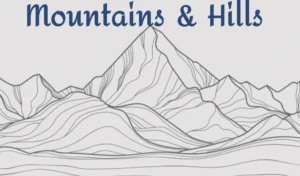India is home to some of the world’s most majestic and diverse mountain ranges and hills, stretching from the towering Himalayas in the north to the ancient Western and Eastern Ghats in the south.
These ranges not only shape the country’s geography but also influence its climate, biodiversity, and river systems.
Understanding India’s mountain and hill systems is essential for students and aspirants preparing for competitive exams, as questions related to physical geography frequently appear in Static GK sections of exams like UPSC, SSC, Banking, and Railways.
This article presents a comprehensive list of all the major mountains and hills across India, along with their location and key features.
Major Mountain Ranges & Hill Systems of India
| Mountain Range / Hill System | States Covered | Highest Peak / Notes |
|---|---|---|
| Himalayas (Greater, Lesser, Shivalik) | J&K, HP, UK, Sikkim, Arunachal | Kanchenjunga (8,586 m), Nanda Devi (7,816 m) |
| Karakoram Range | Northern J&K, Ladakh | K2 (8,611 m) – 2nd highest globally |
| Zanskar Range | Ladakh | Part of Trans-Himalaya |
| Pir Panjal Range | HP, J&K | Passes like Rohtang in Lesser Himalaya |
| Dhauladhar Range | HP | Over 4,800 m; near Dharamshala |
| Shivalik Hills | HP, UK, Punjab, Haryana | Southernmost Himalayan foothills |
| Purvanchal Hills (Patkai, Naga, Mizo) | NE India’s Assam, Nagaland, Manipur, Mizoram | Approx. 4,570 m peak |
| Aravalli Range | Gujarat, Rajasthan, Haryana | Guru Shikhar (1,722 m) |
| Vindhya Range | MP, Uttar Pradesh, Gujarat | ~1,350 m; divides North & South India |
| Satpura Range | MP, Maharashtra, Chhattisgarh | Dhupgarh (1,350 m) |
| Maikal Range | MP / Chhattisgarh | Eastern part of Satpuras |
| Kaimur Range | MP / UP / Bihar | Eastern Vindhya spur |
| Western Ghats (Sahyadri) | Gujarat → Kerala via Maharashtra, Goa, Karnataka, TN | Anamudi (2,695 m) – highest in South India |
| Anaimalai (Elephant) Hills | Kerala / TN | Anamudi part; biodiversity hotspot |
| Nilgiri Hills | TN / Kerala / Karnataka | Doddabetta (2,637 m) |
| Cardamom Hills | Kerala (Idukki district) | ~2,695 m elevation, spice region |
| Eastern Ghats | Odisha → TN via AP | Arma Konda (1,690 m), scattered hills |
| Nallamala Hills | Andhra Pradesh / Telangana | Apollo temples in hills |
| Mahendragiri Hills | Odisha / AP | Coastal Eastern Ghats segment |
| Chota Nagpur Plateau (Rajmahal, Hazaribagh) | Jharkhand, Odisha, MP | Mineral-rich plateau zone |
| Bailadila Hills | Dantewada, Chhattisgarh | 1,276 m; highest point in CH |
| Biligiriranga (BR Hills) | Karnataka / Tamil Nadu border | 1,707 m; corridor between Eastern & Western Ghats |
| Solah Singhi Dhar | HP (Sub-Himalayas) | Up to ~1,200 m; Beas valley boundary |
| Garhwal & Kumaon Himalayas | Uttarakhand | Peaks like Nanda Devi, Kamet |
Key Facts
- India has five major mountain ranges:
- The Himalayas (North)
- The Aravalli Range (Northwest)
- The Western Ghats (West Coast)
- The Eastern Ghats (East Coast)
- The Vindhya & Satpura Ranges (Central India)
- The Himalayas are the youngest and highest mountain range in the world.
- Contains India’s highest peak: Kangchenjunga (8,586 m) in Sikkim.
- The Aravalli Range is the oldest fold mountain range in India and one of the oldest in the world.
- Highest peak: Guru Shikhar (1,722 m) in Rajasthan.
- Western Ghats are a UNESCO World Heritage Site.
- Rich in biodiversity and source of many peninsular rivers.
- Highest peak: Anamudi (2,695 m), Kerala.
- Eastern Ghats are discontinuous and lower in elevation compared to the Western Ghats.
- Highest peak: Mahendragiri (1,501 m), Odisha.
- The Vindhya and Satpura ranges lie in central India, forming the boundary between North and South India.
- Important Hills in India:
- Nilgiri Hills: Meet Western and Eastern Ghats; famous for tea plantations.
- Shivalik Hills: Outermost range of the Himalayas.
- Lushai Hills: Found in Mizoram; part of the Patkai range.
- Mountain ranges influence monsoon patterns, create rain shadows, and serve as natural barriers.
- Several hill stations (e.g., Shimla, Darjeeling, Ooty) are located in these ranges, making them major tourist and strategic military zones.
- Many Indian rivers originate in the Himalayas, Western Ghats, and Central Highlands.

kamagra zásilkový obchod singapore
koupit kamagra online francie
get rifaximin buy generic
buy rifaximin mastercard buy
order xifaxan generic canada no prescription
canadian pharmacy xifaxan generic
cheapest buy avodart price new zealand
cheapest buy avodart canadian sales
online order staxyn without a rx
order staxyn uk online pharmacy
itraconazole with no perscription overnight shipping
itraconazole no perscription usa fedex shipping
Buy fildena online with overnight delivery
Order fildena online without a perscription
how to get womens gabapentin and how much is it
how to order gabapentin generic discount
get flexeril cyclobenzaprine buy in london
ordering flexeril cyclobenzaprine buy in london
ordering dutasteride generic online mastercard
dutasteride without prescription canada
buy androxal cost of tablet
online order androxal generic from canadian pharmacy
kamagra livraison samedi en ligne
acheter kamagra tablette pharmacie
order enclomiphene generic canadian
cheapest buy enclomiphene buy adelaide